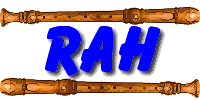

SiteMap
Links

|

|
Miscellaneous
SiteMap Links |
| Fingerings |
| Home |
| Octave 1: |
| F (C) |
| Gb (Db) |
| G (D) |
| Ab (Eb) |
| A (E) |
| Bb (F) |
| B (Gb) |
| C (G) |
| Db (Ab) |
| D (A) |
| Eb (Bb) |
| E (B) |
| Octave 2+: |
| F (C) |
| Gb (Db) |
| G (D) |
| Ab (Eb) |
| A (E) |
| Bb (F) |
| B (Gb) |
| C (G) |
| Db (Ab) |
| D (A) |
| Eb (Bb) |
| E (B) |
| F (C) |
| Gb (Db) |
| G (D) |
|
This site is intended to be a resource for recorder players to obtain the fingerings for Baroque trills, turned trills and regular turns (the 3 symbols at the top of this page). A turned trill is also written with this notation:  I have noticed that in the current recorder literature, while alternate fingerings and standard trills are very well covered, there doesn't seem to be any source that gives the exact fingerings for turns, and especially turned trills. If you want to know how to play a turned trill, you have to get the various fingerings for a regular trill, the various fingerings for the note below your main note, and put it all together yourself. This site does it for you. If you want the fingering for a turned trill for a particular note, just look it up here - all flavors are available - half-step and full-steps above and below the note. Also, I have tried to make the fingering charts easy to use, with little drawings of recorders. I have always found the cryptic fingering notations hard to read, especially since one doesn't consult such things very often. Every time I have to look up a fingering, I have to relearn how the notation works. Although this site started out to just have turned trills, I decided for completeness to include standard trills and also regular turns. I suppose that this site will be useful mostly for intermediate players, who are just getting into trills and other ornamentation. This site is F-fingering (alto) based, although I have given the C equivalents at the top of each page and in the link charts. If you know of any better fingerings for a particular note, I would be happy to hear. Most of the trills and turns are pretty standard, but some of the fingerings (especially on the turned trills) I have derived myself, either from experience or, for the more obscure ones, by trying things till I found something I liked. Also, if you spot a mistake, please let me know. With so many little gif files, I'm sure there are some. A special note about Octave 3 notes Gb, Ab and A, and any fingerings that use them (e.g. the Gb''' to F''' trill; Ab''' to G''' trill, etc.) - I profess no expertise in the use of these notes, so take my fingerings as suggestions only. If you are intent on doing ornamentation in this range, I suggest you check out all the alternate fingerings for these notes at Nicholas Lander's Recorder Home Page, which is a great resource for all recorder-related information (you may very well have arrived at my page from a link on his page :-)).
Meanwhile, I hope you find my site trilling and a turn in the right direction (groan)!
The Turned TrillThe turned trill is encountered frequently in baroque music. It is written and performed: Sometimes you will encounter this notation without the tr symbol. Regardless, it must be performed as a turned trill, in the same way the standard cadential trill is pretty much mandatory. All notes in a turned trill should be slurred. Frequently, the turned trill is preceded by 2 leading notes, as in this example from the beginning of the 5th movement of Handel's Recorder Sonata in C Major:  In a case like this, the 2 preceding notes are often slurred, but the first note of the turned trill should be tongued. The Handel Sonata also demonstrates a feature of turned trills that in my mind differentiates them from regular turns (see below). While the regular turn is an ornament that the performer employs as deemed appropriate, the turned trill is almost always an integral part of the "melody" of the piece, and in that sense isn't really ornamentation at all. Turned trills are often encountered throughout a movement. As the music travels through different keys, the turned trills necessarily change, often requiring only a half-step above or below the main note, sometimes (rarely) both. The Allegro movement of Veracini's Sonata #1 has 7 different turned trills, found in pairs like this:  The TurnThe standard turn is a four note ornament, written and performed: with all 4 notes slurred. When placed between 2 notes, it is performed as a 5 note turn, with all 5 notes slurred:  In the fingering charts on this site, only 4 note turn fingerings are given. For the first note of a 5 note turn (which starts on the main note), use either the standard fingering, or use the alternate fingering (if any) used for the second note in the 4 note turn shown in the fingering chart. Turns are used in a special place, called a "double cadence," which is written and played as:  Often, the tr and turn sign are omitted and you just have to recognize the configuration.
 |